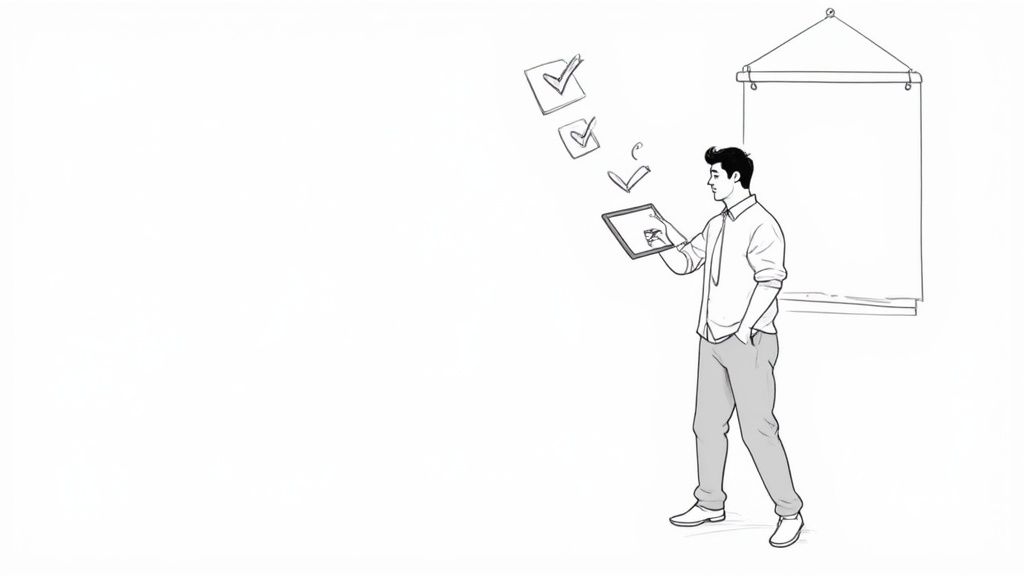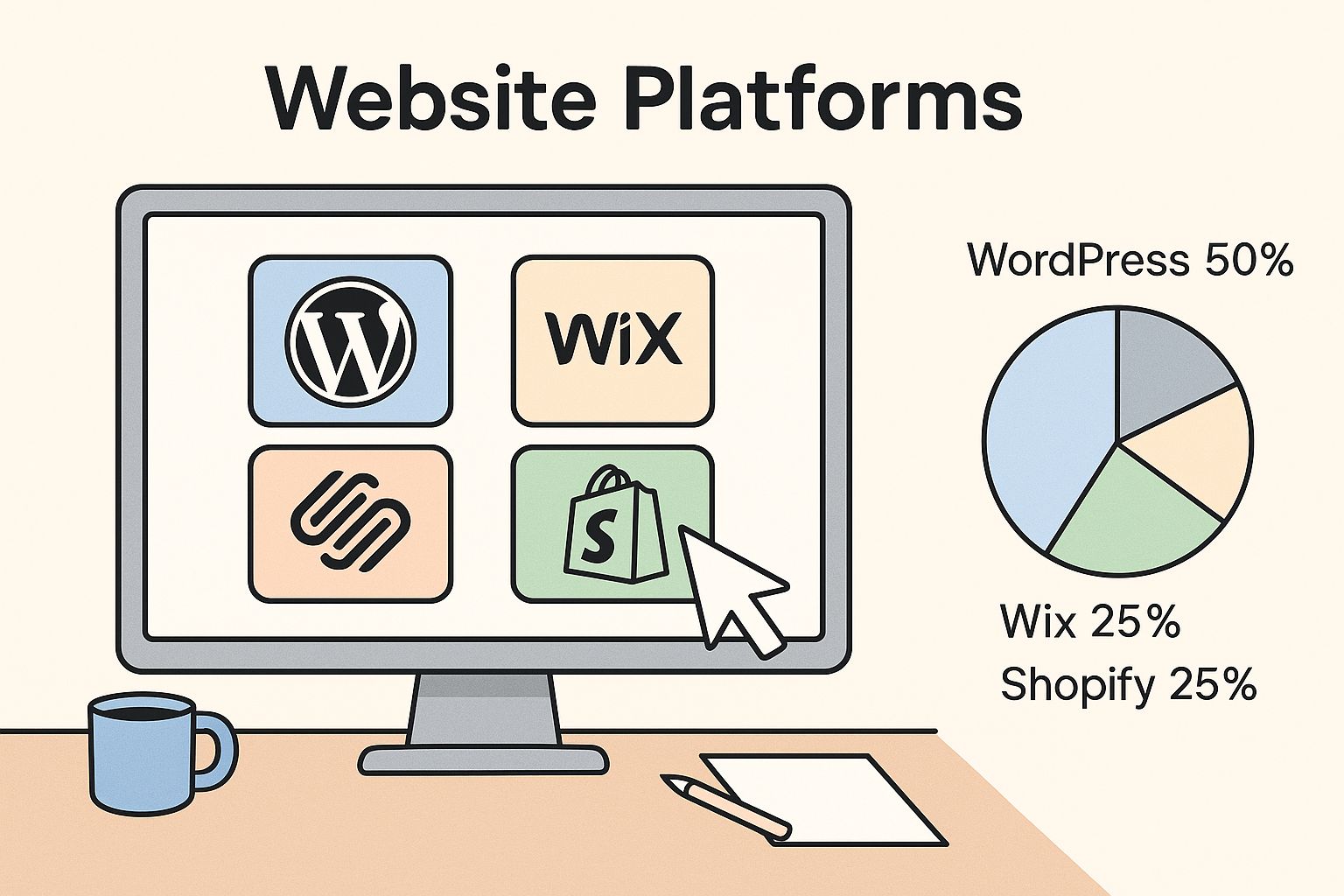How to Create a Digital Portfolio That Impresses Employers

Modified : Jun 12, 2025
Written by: Madeson Sykes
18 minutes read
Why Your Digital Portfolio Is Your Secret Career Weapon

Let’s be real: your resume is just a ticket to the game. Your digital portfolio? That’s your MVP – your Most Valuable Player. I’ve chatted with tons of hiring managers, and they all agree: resumes get a 30-second skim, while portfolios that grab attention get a serious look. The hiring game isn’t what it used to be. Employers want to see your work in action, not just read a laundry list of what you say you can do.
This means your portfolio needs to be more than just a file of past projects. It needs to tell a story – your story. It’s about showcasing not just what you’ve accomplished, but how you tackle challenges and come up with solutions. That’s where the magic happens, where you stand out from the crowd of applicants with similar resumes.
Think of your digital portfolio as your personal brand ambassador, working for you 24/7, even while you’re catching some Zs. It’s the go-to spot for potential employers or clients to get a feel for your skills, your style, and your way of thinking. Building a solid online presence is key, especially with the growing influence of social media. Did you know there are over 5.24 billion active social media users worldwide as of 2025? This highlights how important it is to have a strong online presence. A digital portfolio is your central hub, showcasing your expertise and connecting you with opportunities. For more on this trend, check out this report: Digital 2025.
Making Your Portfolio Irresistible
So, what truly makes a portfolio pop? It’s the small touches that show you’ve put in the effort and care about the details. Here are a few essentials:
-
Visual Storytelling: Use high-quality visuals – images, videos – and concise descriptions to bring your projects to life. Think about the narrative you’re crafting and how each piece fits into the bigger picture.
-
User Experience (UX): Make sure your portfolio is easy to navigate. A clean structure, intuitive design, and fast loading speeds will keep visitors engaged. Consider how Figma or Adobe XD can help you prototype and test the user flow.
-
Personality: Inject your personality into your portfolio! It should reflect who you are as a professional and what sets you apart. This could come through in your writing style, your design choices, or even the types of projects you choose to feature.
By focusing on these elements, you can transform your digital portfolio from a static display into a dynamic tool that draws in opportunities. Remember, your portfolio is more than just a showcase; it’s a conversation starter, a testament to your skills, and your secret weapon in a competitive market.
Finding Your Portfolio’s North Star Before You Build Anything
The biggest mistake I see when folks build their portfolios? Diving into design tools before knowing what they want to say. Seriously, figuring out your message is way more important than picking the perfect font. Think of it like planning a road trip – you wouldn’t hit the gas without knowing where you’re going, right?
This section will walk you through my personal process for helping clients nail down their unique value proposition and target audience. Forget mimicking what everyone else is doing; this is about uncovering what makes you stand out. We’ll look at your existing work, find the golden threads in your best projects, and weave them into a compelling narrative.
 This infographic shows a clean workspace with platform icons on a computer screen. It really highlights the importance of choosing the right platform for your portfolio – something that perfectly aligns with your needs and goals.
This infographic shows a clean workspace with platform icons on a computer screen. It really highlights the importance of choosing the right platform for your portfolio – something that perfectly aligns with your needs and goals.
Beyond that, we’ll cover researching industry standards, finding inspiration from other portfolios (without straight-up copying!), and setting crystal-clear goals. We’ll even talk about what to leave out of your portfolio. Just like a museum exhibit, your portfolio should showcase your best work, not every single piece you’ve ever created.
Defining Your Audience and Goals
Who are you trying to reach with your portfolio? Design agencies? Tech startups? Knowing your audience is like knowing your customer – it helps you tailor your message so it resonates. For example, a UX designer’s portfolio might focus on user research and usability testing, while a graphic designer’s might highlight visuals and branding.
After you’ve identified your audience, ask yourself: What do you want this portfolio to do? Land you freelance gigs? Secure a full-time role? Or just boost your online presence? Having clear goals shapes the projects you showcase and the story you tell.
Auditing Your Existing Work
Take a look at your past projects with fresh eyes. Which ones make you feel proud? What skills do they demonstrate? Look for patterns and themes that connect your strongest work. This helps you identify your core strengths and the kind of work you genuinely enjoy doing.
Building a strong portfolio isn’t just about showing off technical skills; it’s about showcasing your problem-solving abilities and creative thinking. A web developer’s portfolio, for instance, shouldn’t just show finished websites. It should explain the design decisions, the technical hurdles, and the impact of the work. That’s what makes a portfolio compelling.
Let’s break down a few portfolio planning approaches, taking into account your career stage and goals:
Portfolio Planning Framework Comparison
| Planning Approach | Best For | Time Investment | Key Focus Areas |
|---|---|---|---|
| Curated Showcase | Experienced professionals with a strong body of work | Moderate to High | Refining existing projects, highlighting key achievements, tailoring to specific target audiences |
| Targeted Collection | Early-career professionals or those transitioning to a new field | Moderate | Building a foundation of relevant projects, demonstrating core skills, showcasing potential |
| Experimental Playground | Students or those exploring different creative avenues | Low to Moderate | Experimenting with new techniques, showcasing a range of styles, demonstrating passion and learning |
This table gives you a quick overview of how different approaches might work for you. Think about where you are in your journey and which approach resonates most. It’s all about finding the best strategy for your situation.
Picking the Perfect Platform Without Getting Overwhelmed
Let’s face it, choosing the right platform for your digital portfolio can feel like wandering in the wilderness. Having built portfolios on everything from WordPress to Webflow and niche portfolio sites, I can tell you there’s no magic bullet. The best platform depends entirely on your needs, tech skills, and career goals.
This means figuring out your comfort zone. Are you a coding guru or a drag-and-drop devotee? Do you need total creative control, or is ease of use your priority? These are key questions to ask yourself. Your career aspirations matter too. A photographer’s needs are different from a writer’s, which are different from a UX designer’s.
For instance, if you’re a photographer, a platform with beautiful galleries and simple image uploads is essential. But if you’re a writer, clean typography and easy blog integration are what you’ll want. UX designers need interactive elements and a way to show off prototypes. Every field has its own demands, and your platform should support them. This highlights the importance of carefully reviewing each platform based on its features and drawbacks.
Understanding the Trade-offs
Every platform has its pros and cons. A simple platform like Href.sh is perfect for beginners, offering fast setup and easy publishing. You might find Href.sh’s guide on free static website hosting helpful. But it may lack the customization of a more complex platform like WordPress. On the other hand, WordPress offers immense flexibility but requires more technical know-how and ongoing upkeep.
Here’s a peek at the Href.sh interface:

This screenshot shows Href.sh’s simple design, focused on getting your content online quickly and easily. This can be a huge plus for people new to web hosting or who want a straightforward way to publish their portfolio. It also underscores the need to consider the long-term costs, including hosting fees, maintenance, and the time needed to keep your portfolio up-to-date. In the end, the “perfect” platform is the one that best fits your unique needs and goals.
Designing for Humans, Not Just Screens
Building a digital portfolio isn’t about chasing the latest design trends. It’s about creating an experience that genuinely connects with your audience and showcases your work effectively. From user testing and looking at successful portfolios, I’ve learned which design principles really make a difference. You don’t need a design degree to build a portfolio that looks great and works well on all devices.
Color, Typography, and Layout: The Trifecta of Design
Let’s talk color psychology. The right colors can enhance your work; the wrong ones can distract. Think about the feeling you want to create. For instance, blues and greens often suggest calmness and professionalism, while yellows and oranges might bring energy and creativity to mind. It’s not about hard and fast rules, it’s about making choices that support your message.
Then there’s typography. Choosing clear, readable fonts is essential. A professional font instantly elevates your portfolio, while a poor font choice can look amateurish. Try out different font combinations, but always put readability first. Sticking to two or three different fonts is a good guideline.
Finally, the layout. How do you want visitors to navigate your work? A good layout guides the eye naturally, showcasing your best projects and achievements. White space is your friend; it gives your content room to breathe. Steer clear of cluttered designs that overwhelm viewers.
Practical Design Tips for Non-Designers
Creating a visually stunning portfolio doesn’t require professional design skills. Plenty of affordable resources are available. Sites like Canva offer ready-made templates and design elements, making professional-quality graphics achievable for everyone. Maintaining visual consistency—using the same fonts, colors, and style elements throughout—is key to building a cohesive, professional brand.
Keeping up with design trends can also make your portfolio more impactful. The way people interact with online content is constantly changing. For example, experts predict growth in areas like AI and mobile video, influencing how people discover brands. This might mean thinking about how your portfolio could incorporate these trends, perhaps by using AI tools for personalized content. You can find out more about these insights here: Digital 2025 Global Overview Report.
Avoiding Common Design Pitfalls
Some design choices can immediately make a portfolio look unprofessional. Overly busy layouts, clashing colors, and inconsistent branding are major ones. Another frequent mistake is overlooking mobile responsiveness. Your portfolio needs to look fantastic on every device, from smartphones to large desktop screens.
By grasping these basic design principles and avoiding common errors, you can create a digital portfolio that not only showcases your abilities but also presents you as a polished, professional individual. Your portfolio is an extension of your personal brand, so make sure it represents the best version of you.
Telling Stories That Make Employers Want to Know More
Your portfolio isn’t just a display case for finished work. Think of it as a conversation starter, a way to connect with potential employers. The really impressive portfolios I’ve seen don’t just show what was created, but also tell the story of how it came to be. This behind-the-scenes look at your process is what makes you stand out.
Crafting Compelling Case Studies
Every project has a story. How did you tackle the challenge? What roadblocks did you hit (and how did you get around them)? What did you learn along the way? Sharing these insights gives employers a peek into your work style and critical thinking abilities. Let’s say you designed a website. Don’t just show the final design. Talk about the user research that informed your choices, the design decisions themselves, and the impact they had. This shows a much deeper understanding of your skills.
Your portfolio is also a chance to let your personality and professional values shine through. Are you meticulous with details? A natural collaborator? Let that come across in your project descriptions and overall tone. It helps employers connect with you as a person and envision you as part of their team. Need some inspiration? Check out these real-world portfolios on Href.sh examples.
Visual Storytelling Without Overwhelm
Visuals are important, absolutely. But they should enhance your story, not overshadow it. Pick images and videos that showcase key aspects of your work and reinforce your narrative. High quality is a must, but clear, concise descriptions are equally important. Think of visuals like spices – they add flavor, but the core ingredients are what really make the dish.
It’s also worth considering the role of technology in your portfolio creation process. AI is playing a growing role in portfolio design. It can give you valuable insights into how people interact with your content, offer design suggestions, and even automate some tasks. This leads to a more dynamic and responsive presentation. Learn more about these developments in Project Portfolio Management Trends.
Presenting Different Types of Work
Every project is different. A creative project calls for a different approach than an analytical study or a team effort. For creative work, highlight the visual aspects and your artistic vision. For analytical projects, emphasize your data analysis skills and the insights you uncovered. For group projects, showcase your teamwork and communication abilities. The key is to adapt your presentation to the specific work, while keeping a consistent voice and aesthetic throughout your portfolio. This creates a cohesive presentation that highlights your diverse skills and experience.
Getting Your Portfolio Discovered By The Right People
Building a killer portfolio is a huge accomplishment, but honestly? It’s only half the battle. The real challenge lies in making sure it lands in front of the right eyes. Over time, I’ve realized that effective promotion isn’t about spamming every social media platform. It’s about genuine connections and strategic visibility.
Optimizing For Search Engines
Think about it: what would a potential client or employer type into Google when searching for someone with your skills? Those are your keywords. Weaving them into your portfolio content isn’t about keyword stuffing (please don’t do that!). It’s about naturally incorporating terms that accurately reflect your expertise. For example, if you’re a UX writer specializing in SaaS, use phrases like “SaaS UX writing,” “Software documentation,” or “Technical content creation.” See how that feels much more natural?
Also, don’t neglect your title tags and meta descriptions. These little snippets of text are what people see in search results, so make them count! A clear, concise title tag helps search engines understand your portfolio’s focus. A compelling meta description can be the difference between a click and a scroll.
Social Media Strategies That Feel Authentic
Social media is a powerful tool, but it’s easy to get it wrong. The key is authenticity. Share your work, of course, but also give people a peek behind the curtain. Share your process, your inspirations, what gets you excited about your field. This builds trust and makes you relatable.
- Share your process: Post work-in-progress shots, early drafts, brainstorming notes. People love seeing how the sausage gets made.
- Engage with others: Comment on other people’s work, participate in industry discussions, and share valuable content you find. Become part of the conversation.
- Be consistent: Regular posting keeps your audience engaged and reminds them you’re out there. Doesn’t have to be every day, but find a rhythm that works for you.
Networking and Building Relationships
I know, networking can feel icky, but it doesn’t have to be a chore. Focus on building genuine relationships with people in your industry. Go to conferences (if that’s your thing), join online communities like LinkedIn, reach out to people whose work you admire. Offer value, ask insightful questions, and build connections before you need something.
Here’s a simple framework I use:
- Identify key people: Who are the thought leaders in your field? Who are the hiring managers at your dream companies?
- Reach out: Send a personalized message (no generic templates, please!). Mention something specific you admire about their work and ask a thoughtful question.
- Follow up: Stay in touch, share relevant articles, offer support. Nurture those connections.
Measuring Your Progress
How do you know if all this effort is paying off? Data! Track your portfolio’s website traffic using tools like Google Analytics. Monitor your social media engagement and the number of inquiries you’re receiving. These metrics will tell you what’s working and what needs tweaking.
Let’s talk about promoting your portfolio strategically. Here’s a table summarizing a few different approaches:
Portfolio Promotion Strategy Comparison
| Promotion Method | Time Investment | Cost | Potential Reach | Best For |
|---|---|---|---|---|
| Search Engine Optimization (SEO) | Ongoing | Low (mostly time) | Large, targeted | Long-term growth, organic discovery |
| Social Media Marketing | Regular | Low to Moderate (depending on ads) | Varies by platform | Building community, showcasing personality |
| Networking & Relationship Building | Ongoing | Low (mostly time & effort) | Targeted, high-impact | Landing specific opportunities, building industry connections |
| Paid Advertising (e.g., LinkedIn Ads) | Varies | Moderate to High | Large, targeted | Quick boost in visibility, reaching specific demographics |
This table highlights the trade-offs between different methods. SEO is a long game, but it’s crucial for organic discovery. Social media is great for building a community, but requires consistent effort. Networking might be the most time-consuming, but can lead to the most valuable connections.
By analyzing these metrics, you can refine your strategy and maximize your reach. It’s all about continuous improvement.
Keeping Your Portfolio Fresh Without Starting Over
A stale portfolio is a missed opportunity. Let’s be real, rebuilding your website from the ground up over and over is exhausting. The successful designers I know have cracked the code: they keep their portfolios current without burning themselves out. It’s all about creating a sustainable system, not pulling all-nighters every few months.
Practical Update Strategies
Consider your actual schedule. Could you realistically add a new project every quarter? Monthly? Or maybe just a quick refresh of your content every six weeks? Finding a cadence you can maintain is key. Small, consistent updates are way more effective than frantic, occasional overhauls.
Personally, I block out one Friday afternoon each month specifically for portfolio updates. I add new project details, tweak existing descriptions, and generally make sure everything looks polished. It’s become part of my routine now, not a dreaded task.
Seamlessly Adding New Work
Your portfolio should tell a story. When you finish new projects, consider how they fit into your existing narrative. Does the new project reinforce your current specializations? Or does it point toward a new direction you’re exploring? This helps you decide where to feature new work in your portfolio and how to present it.
You can also repurpose older projects to align with your current goals. Perhaps an older project can be reframed to highlight a skill you’re currently developing. Maybe you could add a section showcasing client testimonials or recent awards. These are great ways to add value without a complete rebuild.
Keeping Older Work Relevant
Don’t let your earliest projects fade into obscurity. Think about ways to revisit and refresh them. Consider adding a “lessons learned” section, reflecting on what you’d do differently now. This demonstrates growth and self-awareness, which clients appreciate.
Another effective technique is to update the visuals. Perhaps the screenshots on an older web design project look a bit dated. Replacing them with updated visuals can have a huge impact. Or, if you’re a writer, consider updating an older article with new information or a fresh perspective. This shows your continued development and expertise.
Version Control and Backups
Protecting your work is essential. I learned this the hard way after a website update obliterated an entire section of my portfolio. Use a version control system like Git. It allows you to track changes and revert to earlier versions if something goes wrong. And back up everything! I use a combination of cloud storage and an external hard drive. Trust me, the peace of mind is invaluable.
In the end, maintaining a fresh portfolio is an ongoing process, not a one-time event. By creating a sustainable system that works for you, you can make sure your portfolio remains a valuable tool for showcasing your best work and attracting exciting new opportunities.
Ready to build a portfolio that truly shines? Href.sh provides a simple and intuitive platform for showcasing your work. Check it out: https://href.sh